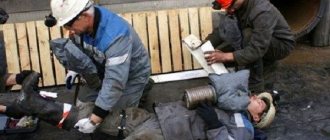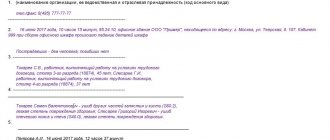If an accident occurred at work. And you are accused under Article 143 of the Criminal Code of the Russian Federation “Violation of labor protection requirements” or under Article 216 of the Criminal Code of the Russian Federation “Violation of safety rules during construction or other work”,
CONTACT US! I WILL PROTECT!
In addition to law, I have a higher technical education. Having extensive experience, I know how to reduce criminal risks.
If one of the company’s personnel dies, is injured or suffers other serious harm to health while performing their work duties or on the way to their place of work, then it is necessary to issue an Industrial Accident Investigation Report. I, lawyer Ermakov A.A., am ready to help with the proper preparation of these documents and compliance with all regulatory requirements.
The industrial accident investigation report must be completed on time and in accordance with the general rules. The current requirements on this issue are set out in the Labor Code of the Russian Federation and Resolution of the Ministry of Labor and Social Development No. 73 of October 22, 2002 (with the latest amendments dated February 20, 2014). These documents, in particular, indicate that during and based on the results of the investigation of an accident that occurred at the enterprise, the responsible persons must document:
- Act N-1 (standard sample for recording an event, its circumstances and measures taken to further prevent such incidents).
- Act N-1PS (same as N-1, but intended for sports organizations).
- The act of investigating an industrial accident that resulted in the death or serious bodily injury of an employee, or affected an entire group of workers.
The standard period for drawing up such documents is from 3 days (for mild incidents) and up to 15 days (for group and severe incidents) with the possibility of extension for another 15 days. The specified forms of industrial accident investigation reports are filled out in several copies and sent to:
- to the employer (to be stored for at least 45 years);
- each victim or his legal representative (in case of a group accident);
- to the insurer;
- at the place of main work (if the injured or deceased is an employee of another company).
When considering the causes and circumstances of an accident that occurred at the enterprise and caused damage to the employee, the commission draws up reports of an industrial accident. They record all the conclusions that the commission came to during the investigation process, they have full legal force and can serve as a basis for re-examination. Labor legislation provides for the following forms of documents for accident investigations.
What accidents are considered non-work related?
Accidents involving workers come in different forms. But not every one of them can be associated with production: be it a minor injury or a serious injury. How to avoid making a mistake in classifying an accident and filing it correctly? Let's figure it out.
The employer must investigate and account for accidents
, if they:
- happened to employees during the performance of work duties or other instructions of the employer (part one of Article 227 of the Labor Code of the Russian Federation);
- led to the need to transfer the employee to another job, to the employee’s loss of ability to work or to his death (part three of Article 227 of the Labor Code of the Russian Federation).
Not related to production
The following accidents are considered to be:
- death of an employee due to a general illness or as a result of suicide confirmed by a medical institution and investigative authorities;
- death or health damage that an employee received while under the influence of alcohol, drugs or other toxic substances (unless this is associated with a violation of the technological process in which industrial alcohols, aromatic, narcotic or toxic substances are used);
- incidents that occurred with the employee during his illegal actions (for example, the employee was injured when, on the instructions of the employer, he was digging up a copper electrical cable on the territory of someone else’s organization).
Notification of an accident at work
This document is the first to be drawn up by the employer in the event of an accident that results in health damage to the employee of varying degrees of severity or causes his death. This form reflects the following provisions:
- legal information about the employing organization;
- time, nature of the work, description of the place and circumstances in which the accident occurred;
- the number of victims and brief information (full name, gender, position, etc.) of each of them;
- the nature and severity of injuries sustained during the incident.
Injury on the way to or from work
If an accident occurred when an employee was going to work or home on corporate transport, then it is recognized as related to production (Article 227 of the Labor Code of the Russian Federation). The situation becomes more complicated when an employee, for example, is injured in an accident on the way to work in a personal vehicle. The injury will be considered not work-related if it is impossible to confirm the fact that the car was used for business purposes. The following documents will be required for confirmation:
- an employment contract that stipulates the condition for using a personal car for business purposes;
- relevant order of the head or local regulatory act;
- waybills or other documents accounting for the employee’s business trips.
If the employee traveled to his place of work by public transport or walked, then the accident with him will also be considered non-productive.
Example No. 1
At the end of the working day, the accountant went to submit reports on behalf of the employer. After that, he immediately went home without stopping at the office. The bus in which the accountant was traveling was involved in an accident, and the employee suffered a concussion. The injury will not be considered work-related because the incident occurred after the accountant was performing his work duties.
Example No. 2
The head of the HR department walked to work. Upon entering the enterprise territory through the gate, the employee slipped on the ice and broke her arm. The injury was recognized as work-related, since it was received within the organization, and the employer did not properly care for the territory belonging to him.
Example No. 3
The head of a department in a company specializing in the sale of elite alcohol was at a wine presentation during working hours, where he participated in the tasting of a new product. After the event, the man went to the office by taxi and got into an accident, as a result of which he received a serious leg injury. Despite the fact that the employee was intoxicated, the accident was recognized as work-related: the head of the department participated in a presentation on the instructions of the director, and the commission did not find a cause-and-effect relationship between the injury and the employee’s intoxication.
Separately, it is worth mentioning accidents with employees on the way to a business trip
. A business trip begins from the moment an employee departs, for example, to the airport or train. If an accident occurs during this time, it can be classified as industrial, taking into account all the circumstances.
In what cases should an act be drawn up?
Not every specific corporation chooses the registration procedure, but the sequence of actions is established by law. Determines the actions of officials in unforeseen circumstances that cause injury, Article 227-231 of the Labor Code of the Russian Federation. The powers are also regulated by the Resolution of the Ministry of Labor dated October 24, 2002.
Accident at the enterprise
Act N-1 is drawn up in case of any accident. But first you need to determine what such an incident is and what the circle of people with whom it can happen. This is an event as a result of which a person suffered injury, damage to health, or death occurred while performing work duties on the territory of the enterprise. Injury while on a business trip also falls into this category. Deterioration in health can be characterized as loss of ability to work for at least one day.
Persons for whom an act can be drawn up:
- those working at the enterprise, including staff at lunch;
- students studying in an educational institution - school, institute, technical school;
- undergoing internship;
- those in prison;
- those engaged in public works;
- on a business trip or internship.
Commission
If health damage occurs to people from the described categories, the responsible persons are required to draw up all the papers required by law and document the incident. Now the circle of people is clear, it remains to determine what an accident is. This term is regulated by Law No. 125-FZ of July 24, 1998 “On Mandatory Social. insurance." In accordance with Article 3 of this law, the term means injury or other harm to health, resulting in loss of ability to work temporarily or permanently, or death. If these conditions are met, an act is drawn up by the commission.
Which situations do not qualify as industrial accidents:
- occurred as a result of manipulations or inactions qualified as criminal;
- death or deterioration in health resulting from taking drugs or alcoholic beverages (if this is not related to the technological process);
- death due to suicide or general illness.
Whether the incident is related to production or not is still decided by the commission.
Important! Article 227 of the Labor Code describes in detail the situations that fall within the definition. These even include insect and snake bites if they occurred during working hours with staff on the territory of the organization in which they belong.
Injury during a scheduled break
The time of breaks and their duration are established by internal labor regulations or by agreement between the employee and the employer (part two of Article 108 of the Labor Code of the Russian Federation). Accident during a scheduled break
may be recognized as production under certain circumstances.
Example No. 1
At the appointed time, the employee went for lunch to a nearby cafe. When entering the establishment, part of the roof fell on him, and the employee suffered a fractured forearm. Despite the fact that the accident occurred outside the organization's territory, it was recognized as production-related. The employee’s employment contract stipulated the conditions for his meals, which the employer undertook to organize in the ill-fated cafe.
With unspecified breaks
the situation is different. An accident that occurs during this time is unlikely to be associated with production.
Example No. 2
During working hours, the secretary went out to smoke in the park next to the office. There she was attacked by an unknown person and took away her mobile phone. The employee suffered a dislocated wrist joint. The accident was not classified as an industrial accident, since the company’s corporate policy prohibits smoking, and internal regulations do not provide for time for smoking breaks.
Duration of drawing up and storage period of the act
In accordance with the Labor Code, a copy that remains with the employer is, according to the rules, stored for 45 years. Also, the head of the company is obliged to preserve investigation materials during this period. The official deadlines for the production of acts can be found in the following list:
- mild degree of health impairment - the paper is completed within 3 days;
- group injuries or a single case with severe injuries or death - 15 days are given to create.
The preparation of Act N-1 in Russia is regulated by labor legislation. By filling out the form, the commission announces the final decision - the degree of guilt of the person in the incident. This paper is necessary for issuing sick leave, disability, and going to court in case of disagreement with the conclusions of the drafters of the act.
Injury during non-working hours
It would seem clear: injuries received during non-working hours are not related to production. But not everything is so simple, because an employee can act in the interests of the employer at any time.
Example No. 1
At the end of the working day, the employee went to dinner with business partners, where he planned to discuss the upcoming deal. The employer provided money for the meeting. During dinner, a fire started in the restaurant. The worker suffered carbon monoxide poisoning and was taken to the hospital. The incident was ruled an industrial accident because the employee was in the restaurant on behalf of the employer.
Regarding accidents during corporate events
, then they cannot be classified as production.
Example No. 2
During a corporate New Year's celebration, employees decided to set off fireworks. The fireworks were not secured securely, and one of the volleys hit the crowd. Several workers suffered burns. The accident was not related to production, because it did not occur during working hours and not while the employees were performing their job duties.
Features of the investigation of accidents not related to production
It is possible to unambiguously classify an accident with an employee only after an investigation, which is carried out in accordance with the general procedure.
.
If the commission, having studied the circumstances of the accident and interviewed witnesses, recognizes the accident as not related to production, it draws up a report. There is an opinion that it should be compiled in any form. However, this requirement only applies to accidents involving professional athletes. In addition, the Labor Code indicates that an accident not related to production must be formalized by an act established
forms.
Form 4
is most suitable for this purpose . The document is drawn up in two copies: for the employer and the employee.
An accident recognized as not related to production does not need to be recorded
in the Occupational Accident Register. Please remember that there is no statute of limitations for investigating a work accident. In addition, the employee can challenge the results of the investigation at any time. Therefore, the employer must retain the accident report and all related materials for 45 years.
Time frames and procedure for investigating an accident
The accident investigation commission and the list of its participants are approved by the employer’s administrative document. The study of all the circumstances of the incident must occur within a strictly established time frame. They depend on the severity of the injuries received by the victim (Article 229.1 of the Labor Code of the Russian Federation):
- For minor health damage – up to 3 days;
- In case of serious consequences for an individual employee or several victims, as well as in case of death - up to 15 days;
- If the injury was not reported to the victim in a timely manner, and the loss of ability to work occurred some time after the adverse event - 1 month.
These periods are determined in calendar days from the date of issuance of the order to conduct the investigation. The law does not establish a statute of limitations for such events, and the victim can claim that he or she suffered a work-related injury at any time from the moment of the incident.
In the course of its activities, the commission must:
- Interview witnesses;
- Inspect the place where the incident occurred;
- If necessary, involve experts to study all the circumstances of the incident;
- Collect documents, security and safety information at the site where the accident occurred.
She is allowed to carry out other actions that ensure high-quality and thorough performance of the duties assigned to the commission.
What liability does an employer face for an accident with an employee?
An accident at work may become a reason for an unscheduled inspection of the organization by the labor inspectorate. In this regard, some employers prefer to hide accidents at work or deliberately document them as not related to production. This threatens the employer with punishment.
Table 1. Employer's liability for an accident with an employee
| Responsibility | |||
| Violation | Executive | Organization | Individual entrepreneur |
| Concealing an accident with an insured employee (Article 15.34 of the Code of Administrative Offenses of the Russian Federation) | Fine from 500 to 1000 rubles | Fine from 5,000 to 10,000 rubles | Fine from 500 to 1000 rubles |
| Violation of labor protection requirements (including incorrect investigation of an accident) (Article 5.27 of the Code of Administrative Offenses of the Russian Federation) | Fine from 1000 to 5000 rubles | Fine from 30,000 to 50,000 rubles or suspension of activities for up to 90 days | Fine from 1000 to 5000 rubles or suspension of activities for up to 90 days |
How does accident classification affect employee benefits?
First of all, the classification of an employee’s accident affects the benefits he is entitled to.
Table 2. Payments to an employee in case of an accident
| Accident | Payments |
| Production related | – Temporary disability benefit; – one-time insurance payment; – monthly insurance payments for the entire period of incapacity; – reimbursement of expenses for treatment and rehabilitation; – payment for additional leave for the period of treatment and travel to the place of treatment; – moral compensation for damage caused (the employee may demand it from the employer through the court) |
| Not related to production | Temporary disability benefit |
Procedure for conducting an accident investigation
When starting an investigation, the commission carries out various actions aimed at identifying all the details of the circumstance. Standard actions are:
- interviewing the victim and possible witnesses;
- a thorough inspection of the scene of the incident;
- attracting third-party specialists with a narrow profile;
- collection of information and documents related to labor protection.
Of course, other actions may be performed at the discretion of the inspectors. The main thing is that they are aimed at a high-quality and reliable investigation. After all the procedures have been completed, the members of the inspection team come to a common conclusion. Experts determine under what circumstances the incident occurred, who is at fault and what injuries the employee received, and how guilty the victim is of the incident.
All this information is included in the act. Its form is chosen depending on who the victim works. Thus, the standard form that is used when receiving a work injury is N-1. However, if a professional athlete is injured, the report is drawn up in the N-1PS form. Moreover, the document is issued only if the injury occurred during a competition or training.
( Video : “Accident at work. How to recover compensation for moral damage”)
Basic rules for filling out the act
As a rule, the document is drawn up in triplicate.
One is sent to the Social Insurance Fund, one remains with the employer and one is given to the employee. It happens that the case is further investigated by third-party specialists. In this case, the required number of copies is made for each side. There must be complete and reliable information about what happened. If several employees are injured, a separate document is drawn up for each of them. As for the commission, it must consist of at least three people. These can be both employees of the organization and third-party specialists. Often the composition of the review team determines the complexity of a particular case. Members of the commission must carefully understand what happened. They determine the degree of guilt of each employee and identify the circumstances that caused the dangerous situation to arise.
One of the main conditions for the correct execution of a document is the affixing of autographs by all members of the inspection team. Moreover, living signatures must appear on all copies.
Instructions for filling out an industrial accident report
The act in form N-1 consists of several pages.
There should be no difficulties in filling them out, because there are hints under the lines. Thus, the document must have a “header” that contains the name of the company, the position of the manager, his passport details, and the date of registration. Next comes the main part, consisting of eleven points. Each of them must be filled out very carefully. All information entered must be true. If there are any inaccuracies, the document may be invalidated. As a result, an injured employee may not receive the social benefits assigned to him in a timely manner. In this case, the employee has the right to demand compensation for moral damage from the employer. In addition to a detailed description of the accident and the actions of the company’s employees, the commission must draw conclusions. In fact, they determine the degree of guilt of a particular employee.
The final stage involves affixing signatures. If the members of the commission come to a consensus, the document is signed. There are situations when the opinions of the review team members differ. They cannot come to a common conclusion. Thus, a specialist who does not agree with the general opinion must indicate weighty arguments for his decision. Although such situations are extremely rare. Usually, the opinions of each member of the commission are taken into account, which allows us to come to a common conclusion. After the document is signed by the inspectors, it is handed over to the director of the enterprise, who must also sign his autograph here.
The most necessary regulations
| Document | Will help you |
| Article 227 of the Labor Code of the Russian Federation | Clarify which accidents can be classified as industrial |
| Article 108 of the Labor Code of the Russian Federation | Study how the time and duration of work breaks are set |
| Article 229.2 of the Labor Code of the Russian Federation | Understand which accidents may be classified as non-work related |
| Article 230.1 of the Labor Code of the Russian Federation | Understand the procedure for registering accidents |
| Article 5.27 of the Code of Administrative Offenses of the Russian Federation | Clarify the extent of liability for an accident at work |
| Article 15.34 of the Code of Administrative Offenses of the Russian Federation | Understand what punishment will follow for concealing an accident |
| Article 14 of the Federal Law of July 24, 1998 No. 125-FZ | Understand how the degree of employee guilt affects the amount of insurance payments for an accident |
| Resolution of the Ministry of Labor of Russia of October 24, 2002 No. 73 | Familiarize yourself with the documents needed to investigate and record industrial accidents |
| Order of the Ministry of Health and Social Development of Russia dated April 15, 2005 No. 275 | Clarify what documents are needed to investigate an industrial accident |
The legislative framework
The procedure for recording, registering and conducting investigations of NS at work is regulated by Articles 227-231 of the Labor Code of the Russian Federation, as well as Resolution of the Ministry of Labor No. 73 of 2002. In particular, paragraph 28 of Resolution No. 73 determined that in the case of a group NS, the investigation commission must additionally draw up an act in Form 4, which is established by the same Resolution. The same act is drawn up in the case of an incident that resulted in serious consequences for an employee or an accident that resulted in death.
Remember the main thing
- The employer is obliged to investigate and take into account all accidents that occurred to the employee during working hours, at the workplace or during the performance of work duties and led to loss of ability to work.
- Accidents that occurred to an employee while intoxicated during his illegal actions, as well as death due to a general illness or suicide will be investigated, but will not be classified as industrial accidents.
- Only a commission can classify an accident after investigating all its circumstances and causes.
- An accident not related to production must be documented in the prescribed form. Form 4 is most suitable for this.
- For an injury not related to production, the employee will not receive insurance payments, but only temporary disability benefits.
Source: Occupational safety: simple and clear
Procedure for compilation
As noted above, the form of the act is established by Appendix 1 to Resolution of the Ministry of Labor No. 73. The document form is the same throughout the Russian Federation. The document is filled out by members of the NS investigation commission (or only one of them), and it must be signed by all participants of this commission. A sample of filling out the document can be found by following the link. The act, sequentially, indicates the following information:
- Type of NS: severe, fatal, group;
- Exact time and date of the incident;
- Name of the organization where the incident occurred, its address, OKVED code;
- Time of investigation;
- List of commission members. Next to each is indicated the position (for example, head of the labor protection department) or whose representative he is (for example, a representative from the administration of Saransk);
- Information about the affected employees: full name, gender, date of birth, position, total length of service and length of service specifically in this organization, marital status;
- Information about ongoing safety briefings. The date of the briefing and its type (introductory, repeated, targeted, unscheduled) are indicated. Information on testing knowledge of safety precautions displayed in the organization’s protocol is also indicated;
- Description of the scene of the incident. The presence of all kinds of equipment (furniture) at the emergency site and their location are indicated;
- Circumstances of the incident. The occurrence of an accident is described step by step;
- A brief description of the causes of accidents (falling furniture, fire of wiring, bursting of a water pipe, etc.);
- A list of persons responsible for this accident, indicating their guilt as a percentage (if such persons are identified);
- NS qualification: group, with severe consequences, with death;
- List of measures (actions) carried out to avoid committing a repeated incident;
- List of attached documents compiled during the investigation;
- List of all commission members. A signature is placed next to each surname;
- Date of preparation.
According to paragraph 28 of the Resolution of the Ministry of Labor No. 73, form No. 4 is drawn up in two copies. Upon completion of the investigation, both documents are transferred to the employer for review and approval of the document. After this, one copy is sent to the prosecutor’s office (to the same place where the notification of the completed NI was sent), the second remains in the custody of the employer. The document is stored for at least 45 years. If during this time the employer is liquidated, the paper is transferred to his legal successor; if there is no legal successor, then to the state labor inspectorate.









